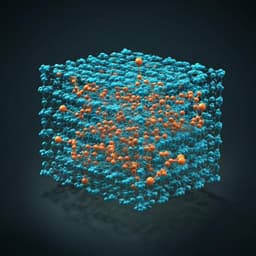
Engineering and Technology
Control of zeolite framework flexibility for ultra-selective carbon dioxide separation
P. Du, Y. Zhang, et al.
Discover the groundbreaking TMCT approach for creating ultra-selective zeolite membranes for CO₂/CH₄ separation, as conducted by Peng Du, Yuting Zhang, Xuerui Wang, Stefano Canossa, Zhou Hong, Gwilherm Nénert, Wanqin Jin, and Xuehong Gu. This innovative method achieved remarkable selectivity and permeance, paving the way for practical applications of all-silica zeolite membranes.
~3 min • Beginner • English
Introduction
Natural gas processing requires efficient CO₂ removal to increase heating value and mitigate corrosion. Although membrane separation is energy-efficient, commercial membranes capture a small market share due to performance limits. All-silica small-pore zeolite membranes (e.g., 8MR DDR/DD3R) offer uniform micropores and robustness but suffer from non-selective macropores formed during high-temperature detemplation (typically 550–700 °C). The principal challenge is the mismatch between zeolite framework flexibility and ceramic support thermal expansion, which generates defects during template removal. Prior approaches (rapid thermal processing, ozonization) have had limited success for 8MR zeolites due to slow diffusivity of reactants/products and long detemplation times (>80 h). The study aims to develop a rapid, facile detemplation strategy that controls framework flexibility and prevents macropore formation to realize ultra-selective DD3R membranes suitable for high-pressure CO₂/CH₄ separations.
Literature Review
Previous work identified non-selective macropores from high-temperature calcination as a scaling barrier for zeolite membranes. Rapid thermal processing has strengthened grain bonding in 10MR MFI membranes (Tsapatsis et al.), and ozonization at moderate temperature mitigated mismatch (Kapteijn et al.). However, 8MR DDR structures exhibit diffusivities for O₂/ozone and decomposition products that are ~100× lower than in 10MR zeolites, leading to inefficient, lengthy detemplation (e.g., >80 h for 8MR DD3R). Despite successful DDR membranes for CO₂/CH₄ (Himeno et al.; Wang et al.), achieving defect-free layers remains difficult. The authors position their TMCT strategy as overcoming these limitations by synchronizing template decomposition with framework relaxation, improving oxidant access and product diffusion, thus enabling defect-free detemplation at moderate temperatures and shorter times.
Methodology
- Supports: α-Al₂O₃ four-channel hollow fibers (outer diameter ~3.6 mm; four inner channels ~0.9 mm; pore size ~0.14 µm; porosity ~40%). Washed, cut (7 or 25 cm), and dried at 200 °C.
- DD3R membrane synthesis: Secondary growth on supports. Synthesis gel molar composition ADA:SiO₂:EDA:H₂O = 3:100:50:4000. ADA dispersed in EDA/water (25 °C), colloidal silica added dropwise, aged 1 h, hydrothermal crystallization at 140 °C for 44 h. Washed and dried at 200 °C. DD3R powders prepared using 0.2 wt% ball-milled Sigma-1 seeds.
- DDR single crystals: N-methyltropinium hydroxide prepared via iodide formation, anion exchange, concentration 0.48 M. Synthesis mixture 70 SiO₂:0.2 Al₂O₃:17.5 N-methyltropinium OH:3050 H₂O, crystallized at 160 °C for 42 days. Crystals up to 109 µm for synchrotron SCXRD.
- TMCT detemplation: Rapid heating to 600/700/800 °C within 1 min, hold 1–240 min (default 700 °C, 1 min) in iodine tungsten lamp furnace, cool to room temperature within 1 min.
- Conventional calcination (CC): 550 °C for 10 h (0.5 °C min⁻¹) for residual template removal; 700 °C for 5 h (CC700) for comparison.
- Gas separation testing: Custom rigs. For binary equimolar CO₂/CH₄ and single-gas permeance, feed ~100 mL min⁻¹, He sweep 100 mL min⁻¹; GC (Agilent 7820A, TCD, HAYESEP-DB) for composition. Permeance Pi = Fi/ΔPi; selectivity αi/j = Pi/Pj. High-pressure (up to 31 bar) tests in dead-end mode without sweep; ΔP corrected for composition/pressure gradients: ΔP = (Pfeed − Pperm) − (Pret − Pperm). Defect contribution estimated using SF₆ (kinetic diameter 0.513 nm) via Knudsen/viscous models with PVis and PKn relations.
- Characterization: FE-SEM (Hitachi S-4800); XRD (Rigaku MiniFlex 600, Cu Kα); CLSM with fluorescein sodium probe; TGA (NETZSCH TG209F1) under air (10 °C min⁻¹) to quantify template content (mass loss 200–1000 °C); N₂ adsorption at 77 K (ASAP2460; outgas 300 °C, 8 h); XPS (Thermo ESCALAB 250XI, Al Kα; C 1s @ 284.80 eV); Solid-state ¹³C MAS NMR (Agilent 600 M / Bruker DSX-300); Thermal expansion of supports (DIL803 dilatometer); High-temperature in-situ PXRD (Malvern Panalytical Empyrean with HTK1200N, 25–900 °C in air, 5 min equil., 17 min scans; Pawley fits; displacement correction; HighScore suite); Single-crystal XRD at Elettra XRD1 (Pilatus 2M; λ = 0.6199 Å; 173 °C; processed with CrysAlisPro; solved/refined with ShelXT/ShelXL in Olex2).
Key Findings
- TMCT prevents macropore formation: One-minute overheating at 700 °C (TMCT) preserved membrane integrity, while conventional calcination (550 or 700 °C; 0.5 °C min⁻¹) produced non-selective macropores (visualized by CLSM; CC showed strong fluorescence; TMCT showed none).
- Template transformation and removal: ¹³C MAS NMR showed template (1-adamantanamine) peaks (29.4, 36.6, 41.4, 46.6 ppm) vanish after TMCT, replaced by sp² carbon signals (124, 127 ppm) and carbonyl (~164.2 ppm). XPS C 1s exhibited a new ~288.9 eV component; nitrogen signals disappeared after subsequent CC, indicating complete removal.
- Porosity evolution: TMCT-only powders had low BET area (71 m² g⁻¹) and micropore volume (0.02 cm³ g⁻¹) with ~58% template remaining (TGA). After TMCT + CC, BET area and micropore volume increased to 349 m² g⁻¹ and 0.14 cm³ g⁻¹, typical of DD3R. CC-only samples had ~25% lower area/volume versus TMCT+CC, indicating residual blockage.
- Crystal symmetry and flexibility: Fresh DD3R refined in R-3m; after TMCT, R-3 symmetry with merohedral twinning captured a staggered O arrangement along c-axis and reduced ADPs. Unit cell volume increased by ~0.45% post-TMCT. Diffuse scattering indicates correlated lattice distortions during template degradation/release. Framework relaxation occurs via corner-sharing SiO₄ tetrahedra rotation about c-axis.
- Thermal expansion: In-situ PXRD showed fresh samples maximize unit cell volume at ~425 °C; TMCT sample at ~325 °C; empty at ~275 °C. TMCT and empty samples exhibit reduced thermal expansion, ~45.9% of fresh (from coefficients). a/b lattice parameters stable up to ~425 °C (fresh); c expands to ~475 °C. TMCT-generated sp² carbon reduces cage occupation, enabling relaxation and lower expansion.
- TMCT parameter effects: During TMCT (no CC), CO₂ permeance increased from 1.5×10⁻¹⁰ to 22.4×10⁻¹⁰ mol m⁻² s⁻¹ Pa⁻¹ as temperature rose 600→800 °C. After TMCT+CC, maximum CO₂/CH₄ selectivity was 442 at TTMCT=700 °C (versus 109 at 600 °C and 55 at 800 °C). Extending TMCT time 1→8 min increased CO₂ permeance 760→890×10⁻¹⁰ mol m⁻² s⁻¹ Pa⁻¹ but reduced selectivity 442→165 (after CC), indicating more non-selective pores with longer overheating. TMCT-only selectivity peaked at ~77 after 8 min (vs α=1.5 for CC700), confirming rapid overheating forms fewer macropores than slow CC.
- Separation performance and scalability: One-batch synthesis produced 17 hollow fiber membranes (total area 405 cm²; 20 cm length each); CO₂/CH₄ selectivity ranged 157–1,172 (average 422). CO₂ permeance achieved 890–1,540 ×10⁻¹⁰ mol m⁻² s⁻¹ Pa⁻¹. Performance surpasses polymeric upper bound and exceeds other zeolite, CMS, and MOF membranes in selectivity. TMCT also applicable to MFI and SSZ-13 membranes.
- High-pressure operation: Up to 31 bar feed. CO₂ flux increased with pressure; at 31 bar: 8.1 Nm³ m⁻² h⁻¹ (pure CO₂) and 3.6 Nm³ m⁻² h⁻¹ (equimolar CO₂/CH₄), with mixture selectivity ~43 and permeate CO₂ concentration 97.7% in single stage. Zeolitic pores contributed 99.99% of CO₂ permeance at 31 bar; slight CO₂ permeance decrease attributed to loading-dependent diffusivity; CH₄ permeance increased with pressure due to reduced hopping barrier. Selectivity with varying feed compositions at 31 bar was 39–50.
Discussion
The TMCT approach synchronizes template decomposition with the framework’s structural relaxation, reducing framework bracing by bulky 1-adamantanamine and temporarily converting it into compact sp² carbon. This decreases cage occupation, enhances oxidant accessibility and product diffusion, and lowers thermal expansion relative to the ceramic support, thereby preventing the formation of non-selective macropores during detemplation. Structural analyses (SCXRD and in-situ PXRD) corroborate a symmetry change (R-3m to R-3), reduced ADPs, and a distinct thermal expansion response, evidencing controlled framework flexibility via rigid unit mode rotations. As a result, membranes exhibit ultra-high CO₂/CH₄ selectivity while maintaining high permeance, outperform polymeric upper bounds and rival advanced inorganic membranes. The scalability to large-area hollow fibers and robust performance under high pressures (up to 31 bar) indicate practical potential for CO₂-rich natural gas upgrading. Parameter sensitivity analysis highlights an optimal TMCT window (brief overheating at ~700 °C followed by moderate 550 °C CC) that maximizes selectivity by minimizing defect formation.
Conclusion
The study introduces a template modulated crystal transition (TMCT) strategy to control DD3R framework flexibility during detemplation, enabling defect-free, ultra-selective CO₂/CH₄ separation membranes. Key achievements include: (i) synchronized template decomposition and framework relaxation (sp² carbon intermediates), (ii) reduced thermal expansion mismatch and improved oxidant/product transport, (iii) record-high selectivity (up to 1,172) with high CO₂ permeance (up to 1,540×10⁻¹⁰ mol m⁻² s⁻¹ Pa⁻¹), and (iv) demonstrated scalability to 17 hollow fiber modules and stable high-pressure operation (31 bar). The approach surpasses the polymer upper bound and offers a path to practical zeolite membrane deployment for CO₂-rich natural gas upgrading. Potential future work includes extending TMCT to other small-pore zeolite frameworks and modules, optimizing TMCT parameters for throughput and uniformity in industrial furnaces, and evaluating long-term stability under realistic mixed-gas, humid, and contaminant-containing conditions.
Limitations
- Performance is sensitive to TMCT parameters; prolonged overheating (>8 min) increases macropore formation and reduces selectivity, indicating a narrow optimal processing window.
- While applicability to MFI and SSZ-13 is noted, detailed performance data for these systems are limited, and generalizability across other frameworks requires further validation.
- Long-term stability, resistance to contaminants (e.g., H₂S, water), and cyclic high-pressure operation were not comprehensively assessed.
- Specialized rapid-overheating equipment (iodine tungsten lamp furnace) may be required to implement TMCT at scale; process transfer to industrial settings was not demonstrated.
Related Publications
Explore these studies to deepen your understanding of the subject.







